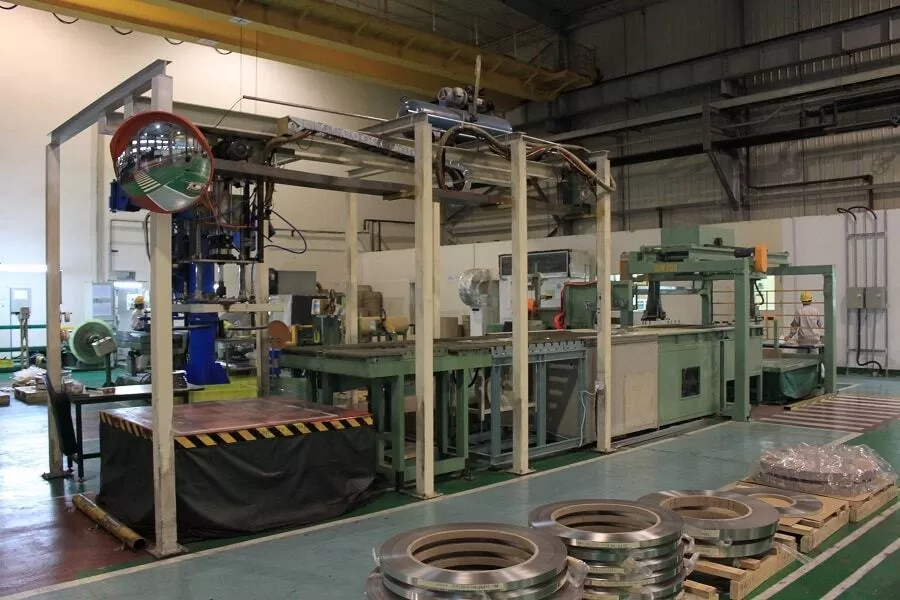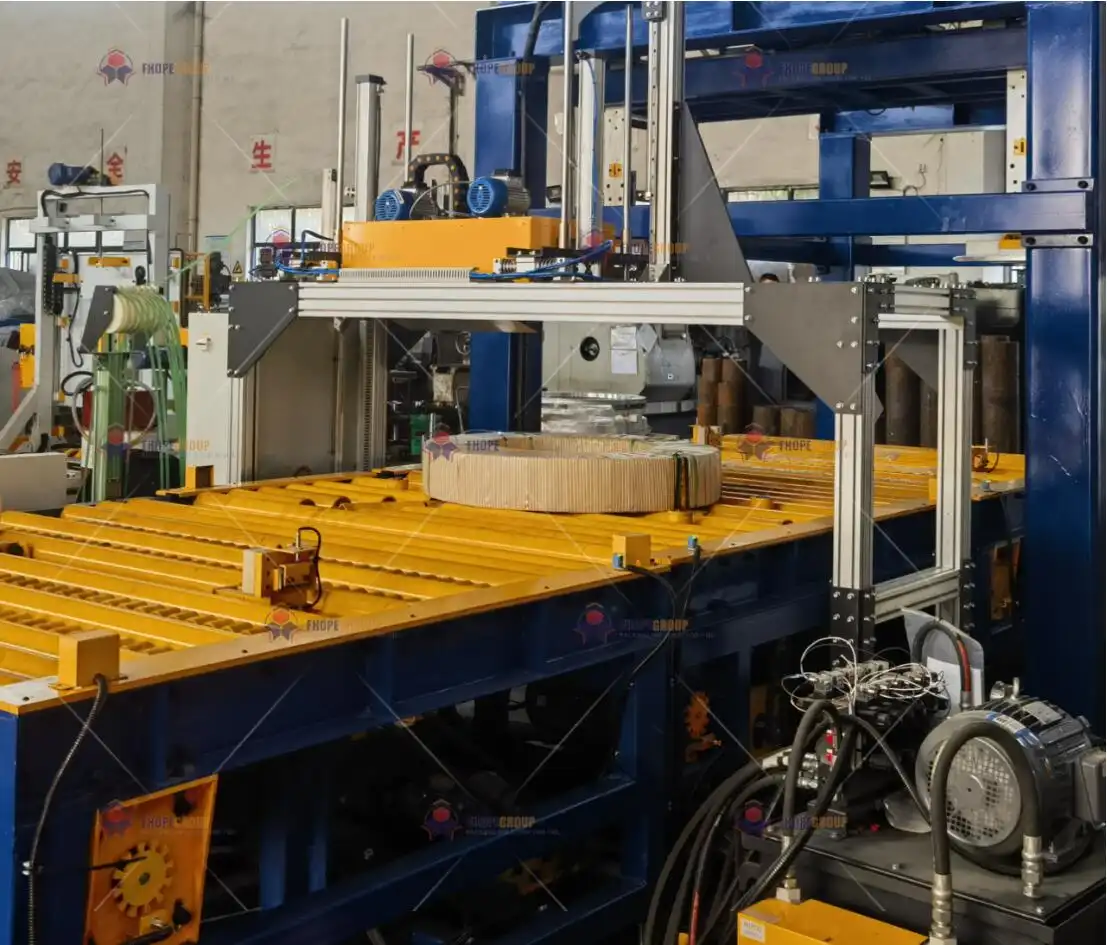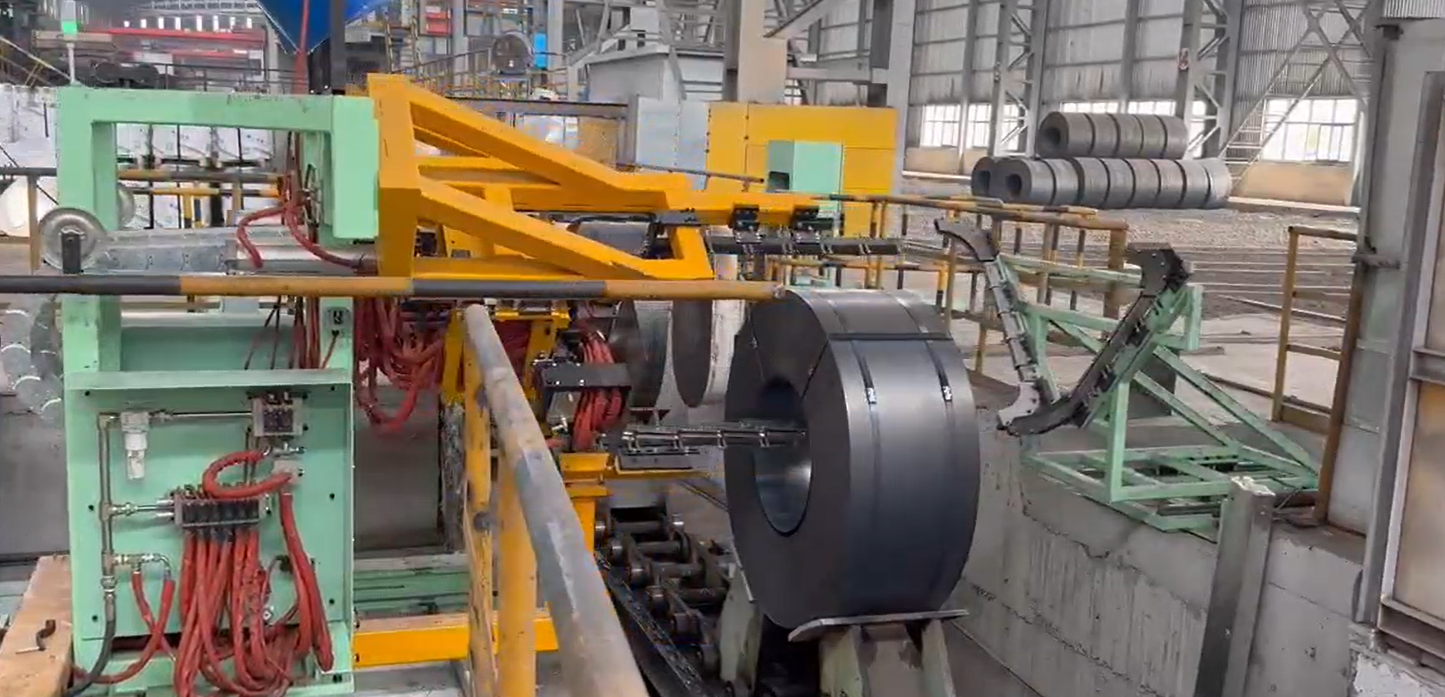In Argentina's demanding steel industry, every peso counts. You work hard to produce high-quality steel coils, but the final packing stage can often feel like a weak link in the chain. Manual or outdated packing methods can lead to inconsistent wrapping, product damage during transit, and customer complaints. These small, daily issues quickly add up, eating away at your hard-earned profits and damaging your reputation. It’s a frustrating cycle where preventable losses become a regular cost of doing business, holding your operation back from its true potential.
The most effective way to improve quality control and minimize waste is to implement a fully automated coil packing system. This technology ensures every coil is wrapped and strapped with machine precision, creating a consistent, protective barrier that prevents damage. Automation also uses the exact amount of packaging material needed, eliminating the significant waste associated with manual application and human error. This leads directly to lower material costs, fewer product rejections, and a more efficient, profitable operation.

I understand that as a steel mill owner, you need to see a clear return on any investment. You are not just buying a machine; you are investing in reliability, efficiency, and your company's future. The idea of automation can seem complex, but the principles behind it are simple and powerful. Let's break down exactly how this technology can transform your packaging process, address your key challenges, and ultimately, strengthen your bottom line. I have walked this path myself, from engineer to factory owner, and I want to share what I've learned.
How Can Automated Coil Packing Directly Enhance Quality Control?
Are you constantly worried about coils arriving at your customer's site with rust spots or edge damage? A single damaged coil can lead to a rejected shipment, a costly return process, and a difficult conversation with a valued client. This isn't just a financial loss; it's a blow to the quality promise you stand behind. The inconsistency of manual packing, where one worker's technique differs from another's, leaves your product vulnerable.
Automated coil packing systems enhance quality control by creating a standardized, repeatable, and highly protective packaging process. These machines apply wrapping materials with consistent tension and precise overlap, forming a uniform barrier that shields the steel from moisture, dust, and physical impacts. By removing the variability of human operators, automation guarantees that the last coil of the day is packed with the same high standard as the first.

Deconstructing the Quality Improvement
Let's look deeper into the specific mechanisms that drive this improvement. It's not just about speed; it's about a fundamentally more reliable process. As an engineer, I've always been fascinated by how small, controlled inputs can lead to massive improvements in output quality.
Eliminating Inconsistent Application
In a manual process, the quality of the wrap depends entirely on the operator. Is the worker tired? Are they new? Are they rushing to meet a quota? These factors introduce variability. One coil might be wrapped too tightly, damaging the edges. Another might be wrapped too loosely, allowing moisture to seep in during transport through different climates in Argentina. An automated orbital wrapper, however, is programmed with specific parameters. It applies the same number of layers, with the same tension and overlap, every single time. This consistency is the foundation of quality control.
Advanced Protective Features
Modern packing lines offer more than just a simple wrap. We can integrate systems that automatically apply VCI (Vapor Corrosion Inhibitor) paper or film. This material releases molecules that form a protective, invisible layer on the surface of the steel, actively preventing rust. It's nearly impossible for a manual operator to apply this material as effectively or efficiently as a machine. The system can also place corner protectors and outer wraps (like HDPE) with precision, providing robust physical protection against forklift damage or impacts during shipping.
Data Logging for Full Traceability
One of the most powerful features of modern automation is its ability to connect to your plant's MES (Manufacturing Execution System). For every coil that passes through the line, the system can log critical data:
- Coil ID
- Date and time of packing
- Wrapping recipe used (number of layers, tension settings)
- Strapping parameters
- Operator ID
This data is invaluable. If a customer reports an issue, you can immediately pull up the packing record for that specific coil. You can prove it was packed to specification, helping resolve disputes quickly. This level of traceability is essential for meeting ISO 9001 standards and satisfying the quality audit requirements of demanding clients in the automotive or appliance industries.
| Feature | Manual Packing Process | Automated Packing System | Impact on Quality |
|---|---|---|---|
| Wrap Tension | Inconsistent, depends on operator strength | Precisely controlled and consistent | Prevents edge damage and loose wraps |
| Material Overlap | Variable, can leave gaps | Programmed for 50% overlap (or other spec) | Creates a complete moisture barrier |
| VCI Application | Slow, often imperfect | Integrated and precise | Maximizes corrosion protection |
| Data Traceability | None or manual logs | Automatic, per-coil data logging | Enables root cause analysis and quality assurance |
What Are the Key Ways Automation Reduces Material and Labor Waste?
Take a moment to think about your warehouse. Do you see half-used rolls of stretch film lying around? Do you notice your skilled team members spending hours on the repetitive, physically demanding task of wrapping and strapping coils? This is waste, plain and simple. The cost of excess packaging material adds up quickly, and every hour your team spends on manual packing is an hour they could be using their skills for predictive maintenance or process improvement—activities that actually add value.
Automation reduces waste by tackling these two areas directly and efficiently. It minimizes material waste through precision. The machine's pre-stretch function can turn one meter of film into three or four meters, drastically cutting consumption compared to manual application. It also eliminates labor waste by freeing your personnel from a repetitive, low-skill job. This allows you to reallocate your most valuable asset—your people—to roles that require human ingenuity and problem-solving.

A Practical Look at Waste Reduction
When I established my own factory, controlling operational costs was my number one priority. I learned that the most significant savings often come from optimizing the small, daily processes that are easy to overlook. Packaging is a perfect example.
The Power of Film Pre-Stretch
This is one of the most immediate and dramatic sources of savings. A typical orbital wrapping machine is equipped with a powered pre-stretch carriage. This unit stretches the film before it's applied to the coil. High-quality systems can achieve a stretch ratio of 250-300%. Let's do some simple math:
- Without Pre-Stretch (Manual): To wrap a coil, you use 100 meters of film.
- With Pre-Stretch (Automated at 250%): The machine stretches 1 meter of film to 3.5 meters. To get the same 100 meters of coverage, the machine only consumes about 28.5 meters of film from the roll.
This results in a material saving of over 70%. For a steel mill in Argentina producing thousands of coils a month, these savings are not trivial. They can amount to tens of thousands of dollars annually, directly improving your profit margin.
Reallocating Your Workforce
Labor is more than just a salary; it's a strategic resource. Manual packing is physically taxing and carries risks of repetitive strain injuries. It's a high-turnover, low-morale job. By automating this task, a process that might require three or four workers can now be supervised by a single operator. Those other team members are now free. You can train them to become maintenance technicians, quality control inspectors, or machine operators on more complex equipment. This not only reduces direct labor costs but also builds a more skilled, flexible, and engaged workforce. It aligns perfectly with the goal of increasing overall plant efficiency and reducing reliance on manual labor for basic tasks.
| Waste Category | Manual Process | Automated Process | Direct Impact |
|---|---|---|---|
| Material Usage | High consumption, no pre-stretch | Minimal consumption, 250%+ pre-stretch | ~70% reduction in film costs |
| Labor Allocation | 2-4 workers per packing station | 1 supervisor for the entire line | Redirects labor to value-added tasks |
| Rework/Scrap | Common due to human error | Nearly eliminated due to consistency | Avoids cost of re-packing & wasted material |
| Safety Incidents | Risk of back/strain injuries | Minimal physical interaction required | Lowers insurance costs and lost time |
Is Investing in Coil Packing Automation Feasible for Argentinian Steel Mills?
As a business owner in Argentina, I know you operate in a complex economic environment. You have to consider currency stability, import regulations, and financing costs with every major decision. The idea of a significant capital expenditure on new machinery can naturally cause hesitation. You might think it's safer to just keep your existing, older equipment running for another year.
But this thinking can be a trap. The "cost" of that old equipment isn't just its maintenance budget. It's the daily bleed of wasted materials, the inefficient use of labor, and the price of every single coil damaged due to poor packaging. A strategic investment in coil packing automation is not only feasible, it is one of the smartest moves you can make to protect your business from these very pressures. The ROI is clear, direct, and measurable, providing a stable return even in a fluctuating economy.

Analyzing the Financial Viability
An investment should not be an expense; it should be a tool for growth. When I made my first major equipment purchase for my own factory, I didn't just look at the price tag. I built a business case. Let's do the same for a steel mill in Argentina.
Calculating a Clear Return on Investment (ROI)
The ROI formula is simple: Annual Savings / Initial Investment Cost. The key is to be realistic about the savings.
- Material Savings: Calculate your current annual spending on stretch film, strapping, and paper. A 70% reduction from film pre-stretch is a conservative starting point.
- Labor Savings: Determine the fully-loaded cost (salary, benefits, etc.) of the workers you can reassign from the packing station.
- Damage Reduction Savings: Analyze your records for the last year. How much did you lose on damaged goods, rejected shipments, and customer claims related to packaging? A 90% reduction here is realistic.
Let's imagine a mid-sized mill. The combined annual savings from these three areas can easily reach $100,000 to $200,000 USD. If a complete, robust packing line has an installed cost of $250,000 USD, the payback period is well under three years. For a machine with a 15-20 year lifespan, this is an exceptionally strong financial case.
The True Cost of Doing Nothing
The alternative to investing is not zero-cost. It's the acceptance of ongoing, unnecessary costs.
- Rising Maintenance: Your 15-year-old equipment will only have more failures, leading to more downtime and higher repair bills.
- Persistent Waste: You will continue to overspend on materials and labor every single day.
- Competitive Disadvantage: Your competitors who do invest in automation will be able to offer better-protected products, possibly at a lower cost because their operations are more efficient. Inaction is a decision to become less competitive over time.
| Financial Factor | Status Quo (Old Equipment) | Automated System (New Investment) |
|---|---|---|
| Capital Outlay | Low (only repair costs) | High (initial purchase) |
| Operating Costs | High and increasing (waste, labor, repairs) | Low and predictable |
| ROI | Negative (ongoing losses) | Positive, often with < 3-year payback |
| Long-Term Viability | Decreasing, risk of obsolescence | Increasing, foundation for future growth |
What Should I Look for in a Coil Packing Automation Partner?
You've analyzed the numbers and you see the potential. You are ready to move forward. But now you face another critical decision: who do you trust to build this solution for you? You've likely seen many suppliers, all with impressive websites and confident salespeople. It can be difficult to tell the difference.
Choosing the wrong supplier is a costly mistake. You could end up with a generic machine that doesn't fit your unique layout, a system that is difficult to service, or a partner who disappears after the final payment is made. This turns your strategic investment into a source of constant frustration. The key is to look for a true strategic partner, not just a vendor. You need someone who understands your industry, can customize a solution, and will stand behind their product for its entire lifecycle.

My Personal Insights: From Engineer to Partner
When I started my journey, I was an engineer on the factory floor. I then became a factory owner who had to make the same decisions you are making now. Because of this, my perspective on what makes a good supplier is very practical. I believe a true partner must deliver on three essential promises.
1. Deep Engineering and Industry Expertise
Your partner should speak your language. They need to understand the difference between hot-rolled and cold-rolled steel, the importance of edge protection for slit coils, and the challenges of handling oily surfaces. A supplier who only knows how to build a standard wrapping machine won't be able to design a solution that truly fits your process. At SHJLPACK, our foundation is engineering. We don't start by showing you a catalog. We start by asking about your production flow, your coil sizes, your crane capacity, and your downstream logistics. This ensures the solution is designed for your mill, not just a mill. This collaborative design process is the difference between a machine that works and a solution that excels.
2. Customization and Seamless Integration
No two steel mills in Argentina are the same. Your layout is unique. Your production goals are specific. A one-size-fits-all approach does not work. A strong partner must have the engineering capability to customize their equipment. This could mean designing a conveyor system that navigates a tight space, building a machine that can handle an unusually wide range of coil diameters, or integrating the packing line controls directly into your plant's MES or SCADA system. This last point is critical for achieving the kind of digital transformation and production visibility that modern leaders seek. True partners build bridges between their technology and yours.
3. Unconditional After-Sales Support
A machine's value is measured by its uptime. Your partner's commitment should not end when the machine is installed. This is where you separate the vendors from the partners. Before you sign anything, ask these questions:
- What is your plan for providing spare parts to Argentina?
- Do you offer remote diagnostic support to troubleshoot issues quickly?
- Will you provide comprehensive training for my local maintenance team?
- What is your warranty, and what does it actually cover?
I built SHJLPACK on the principle of being the partner I always wished I had. We provide detailed documentation, maintain a stock of critical spare parts, and offer support that lasts for the life of the machine. Your success is our success.
| Evaluation Criteria | What to Look For | Red Flag |
|---|---|---|
| Industry Experience | Case studies with steel/metal producers. | Generic, non-specific examples. |
| Customization | Willingness to do on-site visits and custom drawings. | Pushing a standard, off-the-shelf model. |
| Integration | Asks about your MES/ERP/SCADA systems. | Doesn't understand or ask about your software. |
| After-Sales Support | A clear, documented plan for service and parts. | Vague promises of "good service." |
Conclusion
Automating your coil packing is a powerful step. It improves quality, cuts waste, and secures your place in a competitive market. It is a smart investment in your future.




